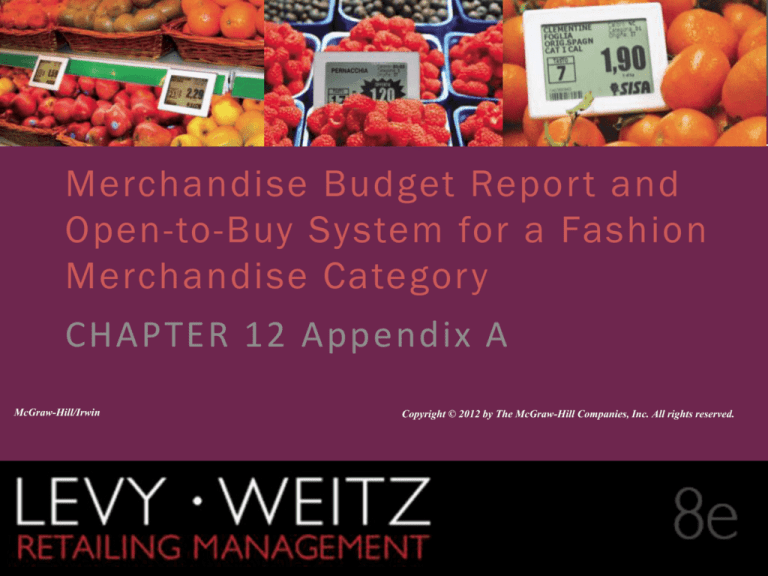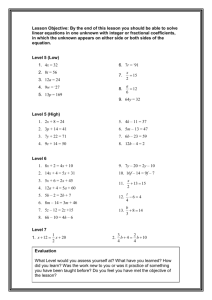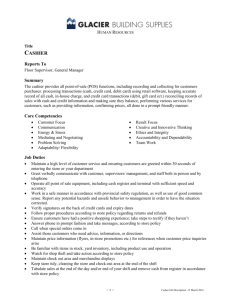
CHAPTER 12
CAHpApPeTnEdRi x1
2
Merchandise Budget Repor t and
Open-to-Buy System for a Fashion
Merchandise Categor y
CHAPTER 12 Appendix A
McGraw-Hill/Irwin
Retailing Management 8e
Copyright © 2012 by The McGraw-Hill Companies, Inc. All rights reserved.
© The McGraw-Hill Companies, All rights reserved.
12A - 1
Merchandise Budget Plan
CHAPTER 12
CAHpApPeTnEdRi x1
2
• In this appendix, we describe the steps in developing
the merchandise budget plan for a fashion merchandise
category.
• These steps are taken to develop the bottom line — line
8, “Monthly Additions to Stock”— in Exhibit 12–16.
• The figures on this line tell the buyer how much
merchandise in retail dollars he or she needs to have, on
average, at the beginning of each month for the
retailer’s financial goals to be met.
12A - 2
Six Month Merchandise Plan
for Men’s Casual Slacks
CHAPTER 12
CAHpApPeTnEdRi x1
2
12A - 3
Monthly Sales Percent Distribution to
Season (Line 1)
CHAPTER 12
CAHpApPeTnEdRi x1
2
The percentage distribution of sales by month is based on
• Historical data
• Special promotion plans
12A - 4
Monthly Sales
(Line 2)
CHAPTER 12
CAHpApPeTnEdRi x1
2
Monthly sales = the forecasted total season for the six-month
period x monthly sales %
12A - 5
Monthly Reductions Percent
Distribution (Line 3)
CHAPTER 12
CAHpApPeTnEdRi x1
2
To have enough merchandise every month to support the
monthly sales forecast, buyers need to consider factors that
reduce the inventory level in addition to sales made to
customers
• Markdowns
• Shrinkage
• Discounts to Employees
12A - 6
Monthly Reductions
(Line 4)
CHAPTER 12
CAHpApPeTnEdRi x1
2
Monthly Reductions = Total reductions x Monthly reduction %
12A - 7
BOM (Beginning of Month ) Stock-toSales Ratio (Line 5)
CHAPTER 12
CAHpApPeTnEdRi x1
2
Stock-to-Sales Ratio specifies the amount of inventory (in retail
dollars) that should be on hand at the beginning of the month
to support the sales forecast and maintain the inventory
turnover objective for the category
Retails often use a related measure, Weeks of Inventory
12A - 8
Steps in Determining
the Stock-to-Sales Ratio
CHAPTER 12
CAHpApPeTnEdRi x1
2
• Step 1: Calculate Sales-to-Stock Ratio
• GMROI = Gross margin% x Sales-to-stock ratio
• Sales-to-Stock Ratio = GMROI/Gross margin %
• Sales-to-Stock Ratio = 123/45 = 2.73
12A - 9
Steps in Determining
the Stock-to-Sales Ratio Continued
CHAPTER 12
CAHpApPeTnEdRi x1
2
• Step 2: Convert the Sales-to-Stock Ratio to Inventory
Turnover
• Inventory Turnover = Sales-to-stock ratio x (1 –
GM%/100)
• Inventory Turnover = 2.73 x (1 – 45/100)
1.50 = 2.73 x .55
12A - 10
Steps in Determining
the Stock-to-Sales Ratio Continued
CHAPTER 12
CAHpApPeTnEdRi x1
2
• Step 3: Calculate Average Stock-to-Sales Ratio
• Average Stock-to-Sales Ratio = 6 months/Inventory
turnover
4 = 6/1.5
12A - 11
Steps in Determining
the Stock-to-Sales Ratio Continued
CHAPTER 12
CAHpApPeTnEdRi x1
2
• Step 4: Calculate Monthly Stock-to-Sales Ratio
• Monthly stock-to-sales ratios vary in the opposite
direction of sales
• To make this adjustment, the buyer considers the
seasonal pattern, previous years’ stock-to-sales ratios
12A - 12
BOM Stock
(Line 6)
CHAPTER 12
CAHpApPeTnEdRi x1
2
BOM Inventory = Monthly sales x BOM stock-to-sales ratio
(line 2)
(line 5)
$98,280 = $27,300 x 3.6
12A - 13
EOM (End-of-Month) Stock
(Line 7)
CHAPTER 12
CAHpApPeTnEdRi x1
2
The BOM stock for the current month = the EOM stock in the
previous month
12A - 14
Monthly Additions to Stock
(Line 8)
CHAPTER 12
CAHpApPeTnEdRi x1
2
Additions to stock = Sales (line 2) + Reductions (line 4)
+ EOM Stock (line 7)
– BOM Stock (line 6)
Additions to stock (April) = $27,300 + $6,600
+ $68,640 - $98,280
= $4,260
12A - 15
Open-to-Buy System
CHAPTER 12
CAHpApPeTnEdRi x1
2
• The OTB system is used after the merchandise is
purchased
• Track of merchandise flows while they are occurring
• Determines How Much Was Spent
• Determines How Much is Left to Spend
12A - 16
Calculating Open-to-Buy
for the Current Period
CHAPTER 12
CAHpApPeTnEdRi x1
2
• Open-to-buy = Planned EOM inventory
- Projected EOM inventory
• Projected
EOM inventory = Actual BOM inventory
+ Monthly additions actual
(received new merchandise)
+ On order (merchandise to be delivered)
- Sales plan (merchandise sold)
- Monthly reductions plan
12A - 17
Calculating Open-to-Buy
for the Current Period
• Projected
EOM inventory = Actual BOM inventory
+ Monthly additions actual
+ On order
- Sales plan
- Monthly reductions plan
=
CHAPTER 12
CAHpApPeTnEdRi x1
2
$59,500
7,000
18,000
15,600
2,310
$66,590
12A - 18
Calculating Open-to-Buy
for the Current Period
CHAPTER 12
CAHpApPeTnEdRi x1
2
• The open-to-buy for the current month is:
• Open-to-buy = EOM inventory - Projected EOM
plan
planned
inventory
$2,050 = $68,640
$66,590
12A - 19
Six Month Open-to-Buy
CHAPTER 12
CAHpApPeTnEdRi x1
2
12A - 20
CHAPTER 12
CAHpApPeTnEdRi x1
2
Retail Inventory
Method
CHAPTER 12 Appendix B
McGraw-Hill/Irwin
Retailing Management 8e
Copyright © 2012 by The McGraw-Hill Companies, Inc. All rights reserved.
© The McGraw-Hill Companies, All rights reserved.
12A - 21
Retail Inventory Method (RIM)
CHAPTER 12
CAHpApPeTnEdRi x1
2
• Objectives
1. To maintain a perpetual or book inventory in terms
of retail dollar amounts.
2. To maintain records that make it possible to
determine the cost value of the inventory at any
time without taking a physical inventory.
12B - 2
The Problem
CHAPTER 12
CAHpApPeTnEdRi x1
2
• When retailers design their financial plans, evaluate
performance, and prepare financial statements, they
also need to know the cost value of their inventory.
12B - 3
Advantages of RIM
CHAPTER 12
CAHpApPeTnEdRi x1
2
• The retailer doesn’t have to “cost” each time
• It follows the accepted accounting practice of valuing
assets at cost or market, whichever is lower
• Amounts and percentages of initial markups, additional
markups, markdowns, and shrinkage can be identified
• Useful for determining shrinkage
• Book inventory can be used in an insurance claim in case
of a loss (e.g., due to fire)
12B - 4
Disadvantages of RIM
CHAPTER 12
CAHpApPeTnEdRi x1
2
• Uses an average markup
• Record-keeping process is burdensome
12B - 5
Steps in RIM
CHAPTER 12
CAHpApPeTnEdRi x1
2
• Calculate Total Goods Handled at Cost and Retail
1. Record beginning inventory at cost ($60,000) and at
retail ($84,000)
2. Calculate net purchases ($39,000 at cost and $54,600
at retail)
3. Calculate net additional markups ($2,000) by
adjusting gross additional markups ($4,000) by any
additional markup cancellations ($2,000)
12B - 6
Steps in RIM
CHAPTER 12
CAHpApPeTnEdRi x1
2
• Calculate Total Goods Handled at Cost and Retail
4. Record transportation expenses ($1,000)
5. Calculate net transfers ($714 at cost and $1,000 at
retail)
6. Calculate the sum as the total goods handled
($100,714 at cost and $141,600 at retail)
12B - 7
RIM Example
CHAPTER 12
CAHpApPeTnEdRi x1
2
12B - 8
Steps in RIM
CHAPTER 12
CAHpApPeTnEdRi x1
2
• Calculate Retail Reductions
1. Record net sales. Gross sales ($82,000) are reduced
to net sales ($78,000) by deducting customer
returns and allowances ($4,000)
2. Calculate markdowns. Net markdowns ($3,000)
arenderived by subtracting any markdown
cancellations ($3,000) from gross markdowns
($6,000)
12B - 9
Steps in RIM
CHAPTER 12
CAHpApPeTnEdRi x1
2
• Calculate Retail Reductions
3. Record discounts to employees ($3,000) and
customers ($500)
4. Record estimated shrinkage ($1,500)
5. Calculate the sum as the total reductions ($86,000)
12B - 10
Steps in RIM
CHAPTER 12
CAHpApPeTnEdRi x1
2
• Calculate the Cumulative Markup and Cost Multiplier
Cumulative markup = Total retail - Total cost
Total retail
28.87% = $141,600 - $100,714
$141,600
Cost multiplier = (100% - Cumulative markup %)
71.13% = 100% - 28.7%
Total cost = $100,714 = 71.13%
Total retail $141,600
12B - 11
Steps in RIM
CHAPTER 12
CAHpApPeTnEdRi x1
2
• Determine Ending Book Inventory at Cost and Retail
Ending book = Total goods handled at retail inventory
at retail - Total reductions
$55,600 = $141,600 - $86,000
Ending book inventory = Ending book inventory
at cost at retail X Cost
multiplier
$39,548 = $55,600 X 71.13%
12B - 12




